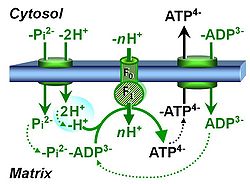Difference between revisions of "Phosphorylation pathway"
| Line 4: | Line 4: | ||
The '''phosphorylation system''' is the functional unit utilizing the protonmotive force to phosphorylate ADP (D) to ATP (T), and may be defined more specifically as the DT-phosphorylation system or '''DT-system'''. The DT-system consists of [[adenylate nucleotide translocase]], [[phosphate carrier]], and [[ATP synthase]]. Mitochondrial [[adenylate kinase]], mt-[[creatine kinase]] and mt-[[hexokinase]] constitute extended components of the DT-phosphorylation system, controlling local AMP and ADP concentrations and forming [[metabolic channel]]s. Since substrate-level phosphorylation is involved in the TCA-cycle, the mtDT system includes succinyl-CoA synthase (GDP to GTP or ADP to ATP). | The '''phosphorylation system''' is the functional unit utilizing the protonmotive force to phosphorylate ADP (D) to ATP (T), and may be defined more specifically as the DT-phosphorylation system or '''DT-system'''. The DT-system consists of [[adenylate nucleotide translocase]], [[phosphate carrier]], and [[ATP synthase]]. Mitochondrial [[adenylate kinase]], mt-[[creatine kinase]] and mt-[[hexokinase]] constitute extended components of the DT-phosphorylation system, controlling local AMP and ADP concentrations and forming [[metabolic channel]]s. Since substrate-level phosphorylation is involved in the TCA-cycle, the mtDT system includes succinyl-CoA synthase (GDP to GTP or ADP to ATP). | ||
|info=[[Gnaiger 2009 Int J Biochem Cell Biol]] | |info=[[Gnaiger 2009 Int J Biochem Cell Biol]] | ||
}} | }} | ||
{{MitoPedia concepts | {{MitoPedia concepts | ||
|mitopedia concept=MiP concept, SUIT concept | |mitopedia concept=MiP concept, SUIT concept | ||
}} | }} | ||
{{MitoPedia topics | {{MitoPedia topics | ||
|mitopedia topic=Enzyme | |mitopedia topic=Enzyme | ||
}} | }} | ||
Communicated by [[Gnaiger E]] 2010-08-15, edited 2016-08-26. | |||
== OXPHOS and substrate level phosphorylation == | == OXPHOS and substrate level phosphorylation == | ||
[[OXPHOS capacity]], measured as oxygen flux in coupled, ADP- and Pi-saturated mitochondria in an [[Pathway control state|ETS-competent substrate state]], may be limited by the phosphorylation system capacity. Mitochondria are the location of the chemiosmotic DT-system, but additionally carry out substrate-level phosphorylation in the TCA-cycle at the step of [[succinyl-CoA synthase]], phosphorylating GDP to GTP or ADP to ATP (taken together as DT). This step must be considered in the mtDT-phosphorylation system. If succinate is externally added to mt-preparations, succinyl-CoA synthase is not involved. However, if succinate is formed in the mt-matrix from 2-oxoglutarate (alpha-ketoglutarate), substrate-level phosphorylation at succinyl-CoA synthase must be accounted for in the interpretation of P/O (P/O<sub>2</sub>) ratios. | [[OXPHOS capacity]], measured as oxygen flux in coupled, ADP- and Pi-saturated mitochondria in an [[Pathway control state|ETS-competent substrate state]], may be limited by the phosphorylation system capacity. Mitochondria are the location of the chemiosmotic DT-system, but additionally carry out substrate-level phosphorylation in the TCA-cycle at the step of [[succinyl-CoA synthase]], phosphorylating GDP to GTP or ADP to ATP (taken together as DT). This step must be considered in the mtDT-phosphorylation system. If succinate is externally added to mt-preparations, succinyl-CoA synthase is not involved. However, if succinate is formed in the mt-matrix from 2-oxoglutarate (alpha-ketoglutarate), substrate-level phosphorylation at succinyl-CoA synthase must be accounted for in the interpretation of P/O (P/O<sub>2</sub>) ratios. | ||
Revision as of 12:29, 8 November 2016
Description
The phosphorylation system is the functional unit utilizing the protonmotive force to phosphorylate ADP (D) to ATP (T), and may be defined more specifically as the DT-phosphorylation system or DT-system. The DT-system consists of adenylate nucleotide translocase, phosphate carrier, and ATP synthase. Mitochondrial adenylate kinase, mt-creatine kinase and mt-hexokinase constitute extended components of the DT-phosphorylation system, controlling local AMP and ADP concentrations and forming metabolic channels. Since substrate-level phosphorylation is involved in the TCA-cycle, the mtDT system includes succinyl-CoA synthase (GDP to GTP or ADP to ATP).
Abbreviation: DT
Reference: Gnaiger 2009 Int J Biochem Cell Biol
MitoPedia concepts:
MiP concept,
SUIT concept
MitoPedia topics:
Enzyme
Communicated by Gnaiger E 2010-08-15, edited 2016-08-26.
OXPHOS and substrate level phosphorylation
OXPHOS capacity, measured as oxygen flux in coupled, ADP- and Pi-saturated mitochondria in an ETS-competent substrate state, may be limited by the phosphorylation system capacity. Mitochondria are the location of the chemiosmotic DT-system, but additionally carry out substrate-level phosphorylation in the TCA-cycle at the step of succinyl-CoA synthase, phosphorylating GDP to GTP or ADP to ATP (taken together as DT). This step must be considered in the mtDT-phosphorylation system. If succinate is externally added to mt-preparations, succinyl-CoA synthase is not involved. However, if succinate is formed in the mt-matrix from 2-oxoglutarate (alpha-ketoglutarate), substrate-level phosphorylation at succinyl-CoA synthase must be accounted for in the interpretation of P/O (P/O2) ratios.

